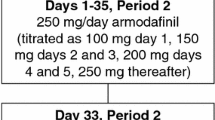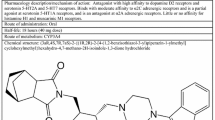Summary
The systemic availability of a new antidepressant, zimelidine, and of its pharmacologically active metabolite, norzimelidine, was studied in six healthy male volunteers. Three single doses of zimelidine (25 mg and 100 mg orally and 25 mg i.v.) and two single doses of norzimelidine (25 mg orally and i. v.) were given to each volunteer allowing at least seven days between administrations. Plasma concentrations of zimelidine and norzimelidine were determined in serial blood samples by HPLC. Following oral zimelidine peak plasma concentrations of the metabolite were attained about 3 h after dosing. Oral administration of norzimelidine itself resulted in a plasma concentration profile for this compound that was similar to that observed after oral zimelidine. Utilising the plasma concentration data following intravenous infusion of each compound, the elimination half-lives for zimelidine and norzimelidine were calculated to be 5.1 h (range 4.3–6.0) and 15.5 h (range 10.6–22.9) respectively. The total body clearances of the 2 compounds were similar at 0.52 l · min−1 (range 0.26–0.70) for zimelidine and 0.56 l · min−1 (range 0.28–0.83) for norzimelidine. The substantially longer elimination half-life of norzimelidine was apparently the result of a larger volume of distribution (9.4 l · kg−1; range 7.8–11.4) for this metabolite, as compared to zimelidine (3.21 · kg−1; range 1.6–4.9). The calculated bioavailability of zimelidine was 26% (range 9.1–39) after the 25 mg oral dose, and 29% (range 14–46) after the 100 mg dose. The bioavailability of norzimelidine was 66% (range 36–91). However, oral administration of zimelidine resulted in as much or more norzimelidine reaching the systemic circulation, as the oral administration of norzimelidine itself. This is important as a large part of the activity of the drug may be due to the metabolite.
Similar content being viewed by others
References
Bertilsson, L., Tuck, J., Siwers, B.: Neuronal effects of zimelidine in man. Psychopharmacology (in press, 1980)
Bradley, S. E., Ingelfinger, F. J., Bradley, G. P., Curry, J. J.: The estimation of hepatic blood flow in man. J. Clin. Invest.24, 890–897 (1945)
Carlsson, A.: Effect of drugs on amine uptake mechanisms in the brain. Bayer-Symposium II, pp. 223–233. Berlin, Heidelberg, New York: Springer 1970
Coppen, A., Rao, R., Swade, C., Wood, K.: Zimelidine: A therapeutic and pharmacokinetic study in depression. Psychopharmacology63, 199–202 (1979)
Gibaldi, M., Boyes, R. N., Feldman, S.: Influence of first pass effect on availability of drugs on oral administration. J. Pharm. Sci.60, 1338–1340 (1971)
Lundström, J., Gostonyi, T., de Paulis, T.: Major metabolites of zimelidine, a new antidepressant, in rat, dog and man. To be published.
Montgomery, S., McAuley, R., Rani, G., Montgomery, D.: A double blind comparison of antidepressant efficacy of zimelidine, a new 5-HT uptake inhibitor, with amitriptyline. Abstracts, 7th International Congress of Pharmacology in Paris, p. 276 (1978)
Ross, S. B., Renyi, A. L.: Tricyclic antidepressant agents. I. Comparison of the inhibition of the uptake of3H-noradrenaline and14C-5-hydroxytryptamine in slices and crude synaptosome preparations of the midbrain hypothalamus region of the rat brain. Acta Pharmacol. Toxicol.36, 382–394 (1975)
Ross, S. B., Renyi, A. L.: Tricyclic antidepressant agents. II. Effect of oral administration on the uptake of3H-noradrenaline and14C-5-hydroxytryptamine in slices of the midbrain hypothalamus region of the rat. Acta Pharmacol. Toxicol.36, 395–408 (1975)
Ross, S. B., Ögren, S.-O., Renyi, A. L.: (Z)-Dimethylamino-1-(4-bromophenyl)-1-(3-pyridyl) propene (H 102/09), a new selective inhibitor of the neuronal 5-hydroxytryptamine uptake. Acta Pharmacol. Toxicol.39, 152–166 (1976)
Ross, S. B., Renyi, A. L.: Inhibition of the neuronal uptake of 5-hydroxytryptamine and noradrenaline in rat brain by (Z)- and (E)-3-(4-bromophenyl)-N, N-dimethyl-3-(3-pyridyl) allylamines and their secondary analogues. Neuropharmacology16, 57–63 (1977)
Westerlund, D., Nilsson, L. B., Jaksch, Y.: Straightphase ionpair chromatography of zimelidine and similar divalent amines. J. Liq. Chromatogr.2, 373–405 (1979)
Author information
Authors and Affiliations
Rights and permissions
About this article
Cite this article
Brown, D., Scott, D.H.T., Scott, D.B. et al. Pharmacokinetics of zimelidine. Eur J Clin Pharmacol 17, 111–116 (1980). https://doi.org/10.1007/BF00562618
Received:
Revised:
Accepted:
Issue Date:
DOI: https://doi.org/10.1007/BF00562618




